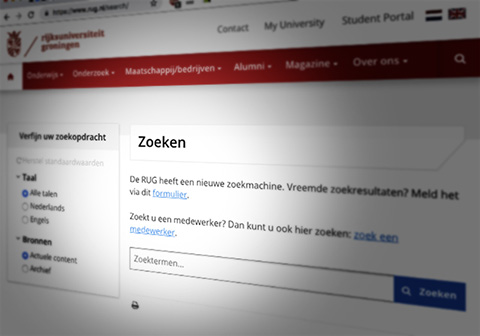A new version of the search engine was launched on Wednesday evening and was supposed to solve most of the issues. ‘But fine-tuning the engine is going to take a while’, says RUG web coordinator Kim Millenaar.
A small UKrant Facebook poll, in which 134 people voted, showed that users are pretty unhappy with the search machine. More than 60 percent said it was ‘really bad’. Millenaar would have liked the engine to work better, but circumstances prevented this. ‘We hadn’t intended to start using it yet, but there were several issues that led to an early launch.’
Tender
The issues started in 2016, when Google announced they were terminating the Google Search Appliance (GSA), a Google function aimed specifically at corporations with search engines on their own websites.
The RUG purchased the system through IT company KBenP. There weren’t many alternatives, as Google was the most used search engine. ‘In an e-mail, Google advised us to switch to Elasticsearch.’
KBenP provided this search engine as well, but their price was so high that the RUG started a private tender process with three different companies. And that took time. ‘Six to nine months, I think. It wasn’t finished until October.’
KBenP won the tender process, but by then the RUG’s IT department had only four months before Google pulled the plug on GSA. ‘It was a race against the clock; we had to launch a new search engine by 28 January or we wouldn’t have anything.’
Adjustments
The tender process started so late, says Millenaar, because for the longest time it wasn’t clear whether Google would come up with its own alternative. In the end, the company contacted them only after the tender process had finished.
‘They’d developed a new, experimental product and asked us if we were interested. I got a little angry at them, because they were so late. But I wouldn’t have wanted to participate in the experiment anyway.’
The big difference between the Google system and the new Elasticsearch is that the former was easier to implement. ‘Google literally came with its own servers, and heaps of them at that. We didn’t have to do much. But with Elasticsearch we have to make a lot of adjustments ourselves.’
Fine-tuning
The crawler, a digital spider that trawls the RUG website to collect relevant information from various pages, the index this creates, and the application programming interface that connects the search engine to the RUG website: IT staff at the RUG have worked on this and more over the past few months.
Not to mention fine-tuning the the algorithm to ensure that the most recent pages show up at the top of the search results rather than pages from the nineties. The engine will learn in part from its users.
The update that was implemented Wednesday should have improved the engine. ‘But I expect further fine-tuning will take us at least another two months.’




